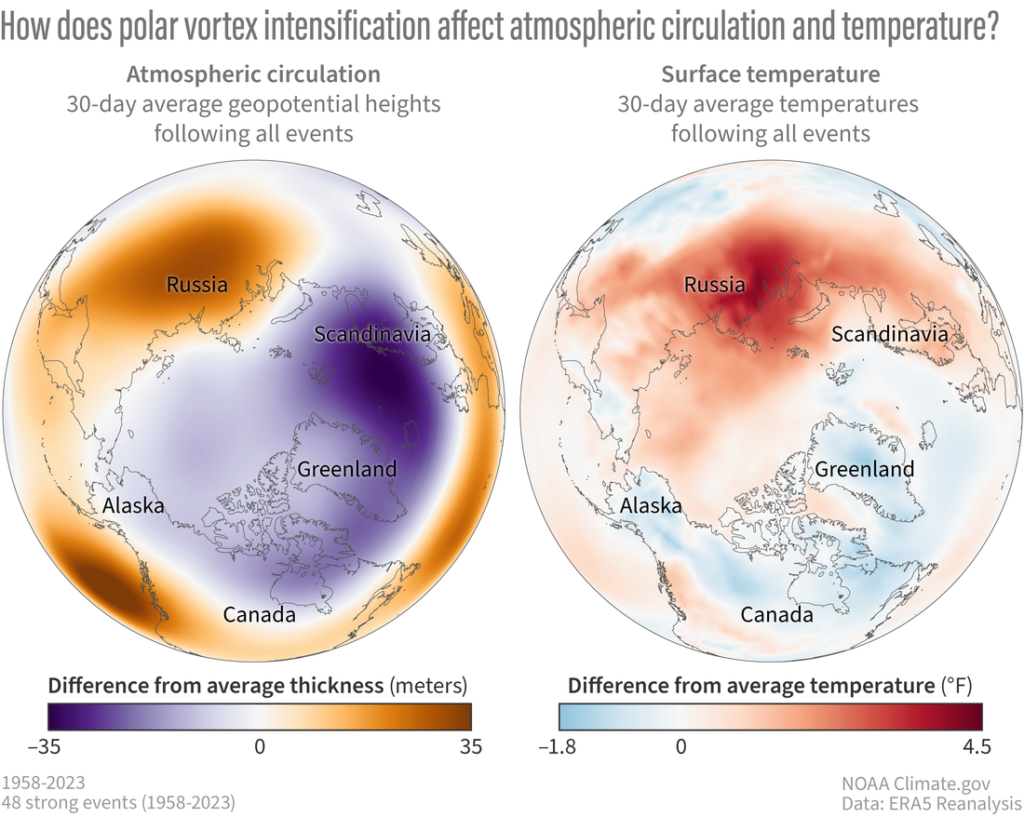When people hear “polar vortex,” they often imagine frigid temperatures and hope their heating systems don’t fail. While disruptions in the polar vortex can lead to cold spells in the eastern U.S. and northern Europe/Asia, the phenomenon is more complex than just these events.
Understanding the Polar Vortex’s Stable Phase
Last season, discussions centered on the polar vortex’s disruptions, where stratospheric winds at 60 degrees North weakened or reversed, causing the vortex to shift or stretch. This year, however, the polar vortex has exhibited a stable phase. The stratospheric winds have been stronger than average, leading to what is known as a polar vortex intensification event. These strong winds help keep cold air confined over the pole.
From Cold Stratosphere to Warm Troposphere
Like disruptions, intensifications in the polar vortex’s stratosphere can influence weather patterns on the surface. Identifying these events involves looking at days when west-to-east winds are in the top 20% of speeds for at least 10 consecutive days. By analyzing these events, we can observe typical weather patterns that emerge after a polar vortex intensifies.

How atmospheric thickness (left) and surface temperature (right) compare to the 1958-2023 average for the 30 days after the 48 observed polar vortex intensification events from 1958-2023. On average, intensification events are followed by lower-than-average thickness (purple) at the 500 hectoPascal pressure level, or about 3.5 miles (5.5 km) in altitude, and cooler-than-average surface temperatures (blue) across much of the Arctic. Across the mid-latitudes, it’s the opposite. NOAA Climate.gov image based on ERA5 reanalysis data provided by Amy Butler.
During these intensifications, atmospheric thickness decreases over the pole, notably around Iceland and northern Norway, while it increases over the Pacific, North Atlantic, and Europe. This results in a less wavy jet stream, preventing Arctic air from moving into lower latitudes. Consequently, parts of northern Asia and Europe can warm up, though effects in North America are less definitive.
These observations highlight where temperature and pressure changes are likely after an intensification. As previously mentioned here, these are not forecasts but typical patterns that don’t always manifest due to other factors like ENSO or daily weather variations.
The stratosphere and troposphere are mostly indifferent to each other. Differences from average atmospheric thickness (“standardized geopotential height anomalies”) in the column of air over the Arctic for the stratosphere and troposphere. Over the last two months, the stratosphere and troposphere have been largely uncoupled. The main exception was in mid-to-late December and late January when the low thickness anomalies (indicative of a stronger than average polar vortex) extended from mid-stratosphere to the surface. The latest forecast from January 29 2025 indicates that this weak interaction will continue for at least the next two weeks. Standardized anomalies are based on departures from the 1991-2020 Climate Forecast System Reanalysis climatologies and have been divided by the standard deviation. Data are from the Global Forecast System observational analysis and forecast. NOAA Climate.gov image.
This year exemplifies how the polar vortex does not always affect surface weather. Despite stronger winds, the stratosphere and troposphere have mostly remained uncoupled, aside from brief interactions in late December and January. Factors other than the vortex likely contributed to unusual snow in the South.
Future Outlook: Persistent Polar Vortex Strength
Observed and forecasted (NOAA GEFSv12) wind speed in the polar vortex compared to the natural range of variability (faint blue shading). Since mid-November, the winds at 60 degrees North (the mean location of the polar vortex) have been stronger than normal. According to the GEFSv12 forecast issued on January 29 2025, those winds are forecast to remain stronger than normal for at least the next couple of weeks (bold red line). By the end of February, there is considerably more uncertainty whether the polar vortex winds will remain strong or weaken. NOAA Climate.gov image.
Forecasts show no significant change in the polar vortex’s strength soon. Some predict potential weakening, but overall, the vortex is expected to remain strong. Currently, no major interaction between the stratosphere and troposphere is anticipated, indicating the polar vortex will likely continue its quiet but robust presence.
Original Story at www.climate.gov
